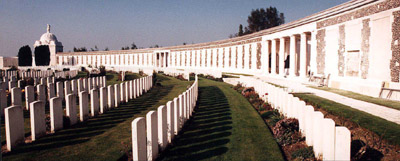Tyne Cot Memorial
The Tyne Cot Memorial forms the northeastern boundary of Tyne Cot Cemetery, which is situated between Passchendaele (now known as Passendale) and Zonnebeke. The name "Tyne Cottages" or "Tyne Cotts" was given by the Northumberland Fusiliers to a group of German blockhouses, or pillboxes, situated near the level crossing on the Passchendaele-Broodseinde road. Three of these blockhouses still stand in the cemetery; the largest, which was captured on 4 October 1917 by the 3rd Australian Division, was chosen as the site for the Cross of Sacrifice by King George V during his pilgrimage to the cemeteries of the Western Front in Belgium and France in 1922.
The Tyne Cot Cemetery is now the resting-place of nearly 12,000 soldiers of the Commonwealth Forces, the largest number of burials of any Commonwealth cemetery of either world war. It first came into being in October 1917 when one of the captured pillboxes was used as an Advanced Dressing Station, resulting in some 350 burials between then and the end of March 1918. The cemetery was much enlarged after the Armistice by the concentration of more than 11,500 graves from the battlefields of Passchendaele and Langemarck and from a few small burial grounds. The dates of death cover the four years from October 1914 to September 1918 inclusive. Unnamed graves in the cemetery number nearly 8,400, or 70% of the total, and the names of the unidentified soldiers who lie in them are inscribed on the Menin Gate and on the panels of the Memorial which stands to the rear of the cemetery.
The site of the Memorial is on high ground on the western slopes of the Passchendaele Ridge, from which the whole country to the English Channel lies open. It is in the middle of an agricultural district, with widely scattered farms and small villages. It represents the most desperate offensive fighting of the Commonwealth Armies in Belgium, as Ypres represents their most stubborn resistance, and it stands close to the farthest point in Belgium reached by Commonwealth arms in the First World War until the final advance to victory.
The Memorial, designed by Herbert Baker and with sculpture by F. V. Blundstone, is a semicircular flint wall 4.25 metres high and more than 150 metres long, faced with panels of Portland stone on which are carved nearly 35,000 names of those who have no known grave. There are three apses and two rotundas: the central apse forms the New Zealand Memorial and bears the names of nearly 1,200 officers and men who gave their lives in the Battle of Broodseinde and in the Third Battle of Ypres (Passchendaele) in October 1917; the other two, as well as the rotundas and the wall itself, carry the names of United Kingdom dead who fell in the Salient between the 15 August 1917, when the Battle of Langemarck began, and the Armistice, in the Third and Fourth Battles of Ypres. Two domed arched pavilions mark the ends of the main wall, each dome being surmounted by a winged female figure with head bowed over a wreath.
Directions
- Date modified:

